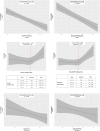Oxygenation improvement and duration of prone positioning are associated with ICU mortality in mechanically ventilated COVID-19 patients
- PMID: 39875763
- PMCID: PMC11775368
- DOI: 10.1186/s13613-025-01438-y
Oxygenation improvement and duration of prone positioning are associated with ICU mortality in mechanically ventilated COVID-19 patients
Abstract
Background: Prone position has been diffusely applied in mechanically ventilated COVID-19 patients. Our aim is ascertaining the association between the physiologic response and the length of the first cycle of prone position and intensive care unit (ICU) mortality.
Methods: International registry including COVID-19 adult patients who underwent prone positioning. We measured the difference for arterial partial pressure of oxygen to inspired fraction of oxygen ratio (PaO2/FiO2), ventilatory ratio, and respiratory system compliance (Crs) between baseline supine position and at either the end of the first cycle of prone position (Delta-PP) or re-supination (Delta-PostPP).
Results: We enrolled 1816 patients from 53 centers. Delta-PP and Delta-PostPP for PaO2/FiO2 were both associated with ICU mortality [OR (95% CI) 0.48 (0.38, 0.59), and OR (95% CI) 0.60 (0.52, 0.68), respectively]. Ventilatory ratio had a non-linear relationship with ICU mortality for Delta-PP (p = 0.022) and Delta-PostPP (p = 0.004). Delta-PP, while not Delta-PostPP, for Crs was associated with ICU mortality [OR (95% CI) 0.80 (0.65, 0.98)]. The length of the first cycle of prone position showed an inverse relationship with ICU mortality [OR (95% CI) 0.82 (0.73, 0.91)]. At the multivariable analysis, the duration of the first cycle of prone position, Delta-PP and Delta-PostPP for PaO2/FiO2, and Delta-PostPP for ventilatory ratio were independently associated with ICU mortality.
Conclusion: In COVID-19 patients with acute respiratory failure receiving invasive mechanical ventilation and prone positioning, the physiological response to prone position is associated with ICU mortality. Prolonging the duration of the first cycle of prone position is associated with improved survival.
Keywords: Acute respiratory failure; Arterial partial pressure of oxygen to inspired fraction of oxygen ratio (PaO2/FiO2); Mechanical ventilation; Prone position; Respiratory system compliance; Ventilatory ratio.
© 2025. The Author(s).
Conflict of interest statement
Declarations. Ethics approval and consent to participate: The registry was designed following the Declaration of Helsinki and the study protocol was firstly approved by the Ethics Committee of the Saint Bortolo Hospital, Vicenza, Italy (Study ID Numbers: 22/21). Patient consent was obtained according to the national regulations of each participating Institution. In cases the patient was incompetent because of critical illness or the use of sedative or anesthetic drugs, consent could be delayed, and a provision for delayed consent was applied: as soon as competent, each patient was fully informed on what had been done, and a written permission of using data collected was obtained. The patients or their legal surrogates were informed of their right to request that the study procedures be discontinued and their right to refuse the study-related use of their medical records. Consent for publication: Not applicable. Competing interests: We declare no competing interests.
Figures



References
-
- Guérin C, Reignier J, Richard JC, et al. Prone positioning in severe acute respiratory distress syndrome. N Engl J Med. 2013;368(23):2159–68. - PubMed
-
- Munshi L, DelSorbo L, Adhikari NKJ, et al. Prone position for acute respiratory distress syndrome. A systematic review and meta-analysis. Ann Am Thorac Soc. 2017;14(Suppl4):S280–8. - PubMed
LinkOut - more resources
Full Text Sources
Miscellaneous

